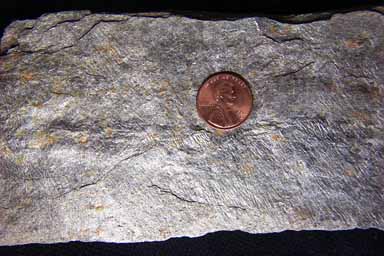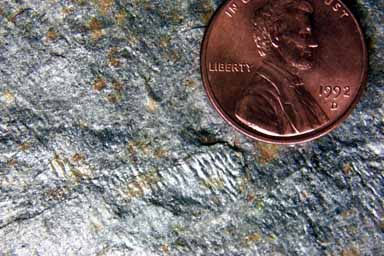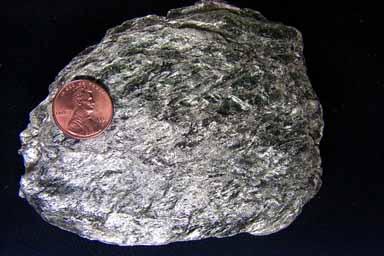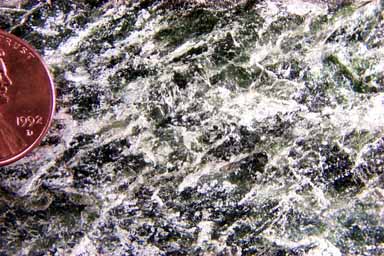
Description
Slaty Cleavage foliation composed of chlorite crystals. Unlike a slate the crystals in this phyllite have grown larger and light reflects more easily off the cleavage faces, leading to a high light reflectance (scheen), a characteristic feature of phyllite.
Since light reflection is so important in getting a feel for this rock, typically the first thing a geologist does upon picking it up is to turn it over and over to catch all the properties and way light reflects. So, if you click on the image it will cycle you through three different views of this rock to see how light plays differently.
Type of Metamorphism
Slates are part of a metamorphic sequence that begins with shale and progresses through slate, phyllite, schist, and gneiss. At the top of this column you can click through rocks showing the changes. Or go to Barrovian Metamorphic Changes.
Composition
Tectonic Association
Schists are typically associated with major mountain building events when shales or clay rich sandstones (wackes) are metamorphosed through depth of burial, and proximity to batholiths (click picture for larger version).
The precursor to this rock is a slate, and if metamorphosed more becomes a schist.
Detail

Description
Slaty Cleavage foliation composed of chlorite crystals. Unlike a slate the crystals in this phyllite have grown larger and light reflects more easily off the cleavage faces, leading to a high light reflectance (scheen), a characteristic feature of phyllite.
Another Sample

Description
Slaty Cleavage foliation composed of chlorite crystals. In this specimen the chlorite crystals are large and distinct enough to be easily seen. Also, the sheen off their surfaces is clearly evident.
Another name for this rock is a chlorite schist, and is applied when the crystals are large and distinct. Unlike other schists, however, where either biotite or muscovite are prominent, in this specimen chlorite is the main mineral. Other minerals are likely present but hard to identify in hand specimen.
Detail

Description
Slaty Cleavage foliation composed of chlorite crystals. In this specimen the chlorite crystals are large and distinct enough to be easily seen. Also, the sheen off their surfaces is clearly evident.
Another name for this rock is a chlorite schist, and is applied when the crystals are large and distinct. Unlike other schists, however, where either biotite or muscovite are prominent, in this specimen chlorite is the main mineral. Other minerals are likely present but hard to identify in hand specimen.
|